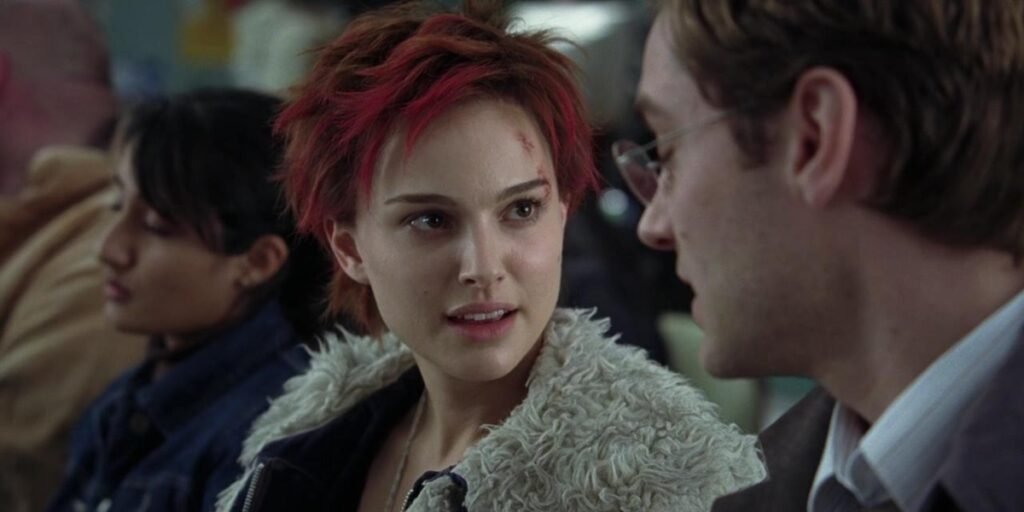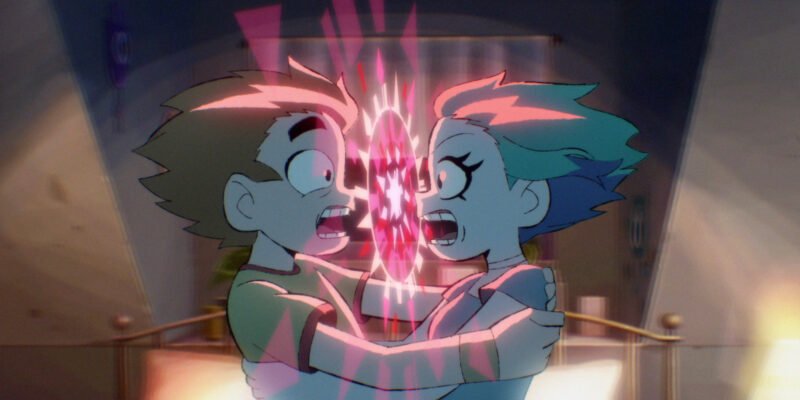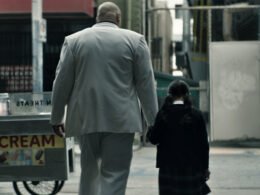Warning: The following contains spoilers for Scott Pilgrim Takes Off.
Scott Pilgrim Takes Off shouldn’t work. For one, its titular character only appears in three of the animated series’ eight episodes. On top of that, every actor from Edgar Wright‘s 2010 cult classic, Scott Pilgrim vs. the World, returns to voice their animated counterpart, inviting a comparison between this series and a film that fans regard as sacrosanct. The show defiantly asks for the smoke. But, when that smoke clears, Scott Pilgrim Takes Off is still standing, and what seemed like arrogance is revealed as well-warranted confidence.
In removing the central figure from the board, the supporting players are given more space to become fully realized characters over the NPCs and boss battles they are in Scott Pilgrim vs. the World. By bringing back the film’s now star-studded cast, the series successfully celebrates a beloved movie while interrogating its premise. For fans of a certain age (as I am), that interrogation extends beyond the story and continues within ourselves. But it’s difficult to delve into that interrogation without first contextualizing the film with which the series exists in conversation.
‘Scott Pilgrim vs. the World’ Set a Strong Foundation

I was 26 years old when Scott Pilgrim vs. the World premiered in 2010, but I was likely closer to 27 the first time I saw it in 2011. I wasn’t alone in taking my time to find the movie. Against an estimated $60 million budget, the film’s $47.7 million worldwide gross makes it an undeniable box office bomb. Still, the movie found its audience, garnering praise from both critics and audiences and nearly matching its domestic box office numbers in domestic home video sales.
Scott Pilgrim vs. the World feels like a movie made specifically for me. The film moves with restlessness to get to the next scene/line/frame in a way to which anyone with ADHD can relate. The jokes come fast and often, like a 30 Rock script for the GameStop crowd. The music rips, the colors pop, and even though the story is set in an extremely stylized and heightened version of Toronto, the constant shuffle from a friend’s house to the coffee shop to another nightclub to see a live, middling indie band to the afterparty at another friend’s house surely resonates with anyone in their 20s.
In 2011, I became a father — a circumstance for which there is no analog in the Pilgrim-verse. But you don’t truly feel like a bona fide parent for years after your first child, especially if that child arrives before your 30th trip around the sun. You’re still just cosplaying as an adult for a little while. Functionally, the 2011 version of me was Scott Pilgrim with a new baby.
And so, just as I was being thrust into the next evolution of myself, Scott Pilgrim vs. the World was there to tether me to that middle existence between immaturity and adulthood. As that delineation became clearer, and I felt less like three children standing on each other’s shoulders in a trench coat and more like an actualized grown-up, Scott Pilgrim vs. the World evolved into an instant time machine to my mid-20s.
The Ringer‘s Joanna Robinson is right: Scott Pilgrim vs. the World is a perfect film. That is, there isn’t a film with more confidence in its vision, taking as many chances, and delivering with as much efficiency and expertise as Scott Pilgrim. That is not to say, however, that the film is above scrutiny.
‘Scott Pilgrim’ Had a Ramona Problem

At the center of every iteration of the Scott Pilgrim story, amidst all the drums and guitars and cartoonish violence, is the relationship between Scott Pilgrim (Michael Cera) and Ramona Flowers (Mary Elizabeth Winstead). Scott wants to be with Ramona but must battle Ramona’s seven evil exes to do so. From the vantage of the story being a love letter to classic video games, the idea of seven boss battles of increasing difficulty is as old as the OG Nintendo.
But because of the structure of Scott’s hero’s journey, Ramona becomes less a woman with her agency capable of making decisions about her love life, and more a trophy to be won. Yes, there is an allegory at work about overcoming baggage — ours as well as the other person’s — when we enter into new relationships, but it’s a loose fit at best. The film’s frenetic pacing, a strength for the most part, doesn’t allow Scott and Ramona to ever really spend enough time getting to know each other to the point that the relationship feels earned or real.
In essence, Ramona is more an idea than a person, the literal girl of Scott’s dreams (there’s a subspace highway that cuts right through his brain — a tale as old as time), and an object of desire for Scott and the League of Evil Exes. I wish I could say that I clocked this flaw in the film upon my first or even fifth viewing. Embarrassingly, I, and I suppose many men of my generation, are suckers for a Manic Pixie Dream Girl.
What Is a Manic Pixie Dream Girl?

Cinema in the late ’90s and ’00s was lousy with the tales of hapless men, depressed in their stations, who are jolted into life and love through the whimsy of a Manic Pixie Dream Girl (“MPDG”). You know the type; she’s a free spirit and a ray of sunshine to counter our protagonist’s gray cloud persona. She pulls him out of his rigidity and reignites his joie de vivre with her “seize the day” disposition and oh so much pluck. Dharma and Greg ran for 119 episodes over 5 seasons on this premise alone. Elizabethtown, Along Came Polly, and Forgetting Sarah Marshall all feature them.
The trope betrays an immature view of women, at least as they exist as fixtures in narratives, and should be called out whenever it arises in a story without comment or irony. A great deal of the fundamental disconnect in the minds of misogynists, and especially incels, is that women exist for men. While there are certainly myriad enablers of this neolithic mindset, the concept of a female character whose sole function in a story is to motivate and love the male protagonist, generally without calling his flaws into question, is one such enabling force.
Ramona Flowers vs. the Manic Pixie Dream Girl Trope

In Scott Pilgrim vs the World, Ramona has all the trimmings of an MPDG, with a couple of subversions. First, she’s not manic. She’s at least as depressed as Scott. Where Scott has insulated himself from ever feeling the pain of his one devastating breakup, Ramona is trying to isolate herself lest she create another evil ex. Secondly, she doesn’t pull Scott from his rigid existence into a freer state of being, she compels him to leave his insular bubble of slackerdom and, if anything, become a little more rigid for his good.
By 2010, Hollywood had well begun interrogating and deconstructing the MPDG trope (including some cornerstone examples from stories that no doubt inspired Scott Pilgrim Takes Off, but more on that later). Natalie Portman, who plays the quintessential MPDG in 2004’s Garden State, also plays a deconstructed version of one in 2004’s Closer, where Dan (Jude Law), a stunted writer, is enchanted with the concept of being with the free-spirited Alice (Portman) but becomes disenchanted with her once she’s served her purpose and he’s realized that she’s a person with her own needs, flaws, and scars.
Scott Pilgrim vs. the World doesn’t fully fall victim to the MPDG trope, but it would be a stretch to call Ramona a deconstruction of it.
‘Scott Pilgrim Takes Off’ Honors the Themes of the Original by Subverting Its Story

Upon the announcement that the film’s original cast would all reprise their roles, Scott Pilgrim vs the World fans assumed the Netflix anime would be a stretched-to-fit-the-episode-order retelling of the film. And for most of the first episode, that assumption appears to be warranted. But in the episode’s closing moments, it’s clear that we’ve entered an alternate version of this story. Our expectations thwarted, the series pulls the magic trick of utilizing the same characters, played by the same cast, set in the same milieu, wrestling with the same theme, but in new, exhilarating, and often elegant ways.
If there’s one central and uniting theme to all versions of the Scott Pilgrim story, it’s the broken versions of ourselves we become after our breakups. Scott is in a self-imposed arrested development; Ramona is reticent to create her 8th evil ex; Kim (Alison Pill) is emotionally callous; Knives (Ellen Wong) becomes vengeful. Scott Pilgrim Takes Off engages that same theme, but rather than dwelling solely on Scott’s breakup trauma, the narrative shifts to Ramona, and in doing so, lets us explore everyone else’s.
When Ramona discovers that Scott isn’t dead but that he has been taken, her search for whodunnit leads her to encounters with her exes. Suddenly, Ramona evolves from the Pixie Dream Girl to the story’s protagonist. Scott Pilgrim Takes Off takes a page from Nick Hornby‘s ode to breakups in the time of punk rock, High Fidelity. (High Fidelity tells the story of Rob, a record store owner who, having just been dumped, goes on an odyssey of the top five breakups in his life to find out why his relationships seem doomed from the outset. If you enjoy Scott Pilgrim Takes Off, seek out the novel by Hornby, the 2000 film starring John Cusack as Rob, and the 2020 Hulu series starring Zoë Kravitz, also playing Rob.)
Ramona’s League of Evil Exes Get Redemption

Though there simply isn’t enough runway to explore each member of the League, Ramona’s exes are revealed to be not evil, just hurting. The high point of the series is Episode 3, “Ramona Rents a Video,” centered on the confrontation between Ramona and her one female ex, Roxie (Mae Whitman). We see in flashbacks that Ramona left Roxie without a warning or closure. In that devastation, Roxie’s villain origin story began. Aside from Roxie, the series examines Kim, Lucas Lee (Chris Evans), and Todd (Brandon Routh) while also allowing Knives a more graceful route to growth and self-discovery and mercifully sparing us the (at best) cringefest of witnessing Scott dating a high schooler.
What comes of this plot deviation is a deeper understanding of these characters whom we love even more than we did going in. It’s truly remarkable that as iconic as the movie is, for many, the Takes Off version of these characters will be their preferred iteration. By focusing on the story’s central theme, Scott Pilgrim Takes Off deconstructs the League of Evil Exes. These are all just people, trying to find their way, stunted by their trauma. With the League out of the way, the series deals with the greatest evil ex of all.
Days of Future Scott

Of course, this series gets on the time travel/multiverse train. Old Scott (Will Forte) age 37, brings Scott Prime to the more-futurey-than-expected future of 14 years from now to tell him that although he and Ramona are destined to fall in love and get married, it will be all for naught. Their love story will end, and it will be the most painful experience of Scott’s life. Old Scott joins Joel, the protagonist of Michel Gondry‘s Eternal Sunshine of the Spotless Mind (itself a masterful meditation on heartbreak and trauma), in subscribing to the credo that it’s better to have never loved at all than to have loved and lost.
The climactic battle between the entire cast of Scott Pilgrim Takes Off and Even Older Scott (also Forte) is nothing short of anime at its anime-ist. It’s also the last stand for the central theme. Even Older Scott represents the final, Super Saiyan-esque form of Scott’s instinct to protect himself from emotional injury.
In the devastation and loneliness of the past decade without Ramona, Even Older Scott becomes a pain golem. He’s stronger, faster, and bigger than Scott, complete with vegan powers, but he is no match for the combination of Scott and Ramona together. In the end, Scott Pilgrim Takes Off joins Eternal Sunshine in unapologetically proclaiming that although love may very well end in pain, living in fear of love is no life at all. It’s a beautiful sentiment, stated more clearly than the film manages, without losing any of the silliness, fun, or awesomeness we’ve come to expect from all things Scott Pilgrim.
Scott Pilgrim Grows Up

Over the Thanksgiving holiday, I reached my 40th birthday. I suppose I’m now Old Carlos. I’ll always be grateful for Scott Pilgrim vs. the World. It’s my comfort movie. In a sense, it’s the movie I can turn on when I want to hang out with a younger version of myself for a couple of hours. But I’m not that younger person anymore. And that’s a good thing.
As Scott Pilgrim Takes Off teaches us, none of us are the past versions of ourselves. We are shaped, but not defined, by their experiences. Our failures are just as fleeting as our triumphs, and we reinvent ourselves every time we dare muster up enough bravery to step out into the world knowing we’ll suffer its slings and arrows. I’ll always be grateful for Scott Pilgrim vs. the World, but I’m so very happy that Scott Pilgrim Takes Off is maturing Scott’s — and Ramona’s — story right along with me.
Follow the Agents of Fandom socials for all the latest entertainment news and reviews.











